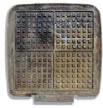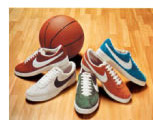|
|
 |
|
 |
 |
|

Eugene, Oregon’s mayor inspires the winner of the 1973 Boston Marathon. Here’s
the story: Jon Anderson—a ‘72 Olympian who’s considering leaving
running all together—is the mayor’s son. He calls his father 3 weeks
before the Marathon telling him he’s thinking of not going to Boston. The
mayor does Jon and Nike a favor: he convinces Jon to run. Anderson wins with tears
in his eyes and the Swoosh on his feet—it’s a turning point in our history,
and it’s not the first inspired by a man from Eugene.

True story: Bill Bowerman was having waffles one morning. Sometime around ‘72.
Struck with inspiration, he ran to his garage and filled his wife’s waffle
iron with latex rubber. His result: a ruined waffle iron, a better and lighter
outsole, and a company with big, big plans. That’s how it went.

Track meets were our primary method of getting the name out, but athletes weren’t
allowed to wear branded apparel. Fortunately, we were such a minor player that
runners could wear the cursive “nike” and the authorities just wondered
who “Mike” was. And the Swoosh was cryptic code to all but the most
in-the-know. We had a card up our sleeves for the competition too: because each
of their models was a specific color, you could readily see what they were bringing
to market. We had more ideas than goods—one was to give as many athletes
as we could their own colored-up shoes. A win-win: athletes felt personalized
and the competition felt like we were breathing down their necks. They were both
right.


In 1977, frustrated by the American running hierarchy’s inability to keep
pace with Eastern Europe, Nike starts Athletics West. Its logo—fir tree,
snow-capped mountains, Old West typeface—and name are symbolic of new thinking
emerging from the corner of the country. Athletics West debuted in ‘77…and
soon, American athletes surged back to prominence. A perfect prelude to an Olympiad—alas,
that would be Moscow 1980. The resulting credibility for the young brand solidified
Nike’s reputation as “The Running Company.”

It’s 1974, and a two-year old company is riding two big winners. The Waffle
Trainer is selling like hotcakes and Steve Prefontaine, who the previous year
had become the first major athlete to wear Nike shoes, is the most visible track
athlete in the land. Heady times for a young company, but we learned early on
that you can go a long way with the top athlete—and the top shoe.

Mid-’70s, and an early Nike basketball endorsee is in Portland for a game.
Day of game, in the locker room, man needs shoes. Our man in Eugene has a pair
for him—so he heads north on I–5, and fast. Of course, he has no ticket
for the game, much less a security pass. So what was to be the Nike Moment here?
A skinny ex-U of O runner talking his way past security? Or talking his way into
the visitor’s locker room a few minutes before gametime? The look of surprise
and gratitude on an NBA star’s face. Whoever he was playing for. That was
the Nike Moment.

In his debut at 1980’s New York Marathon, Alberto Salazar had handed in his
finish time of 2:10 prior to the race. Race officials rolled their eyes. When
it was over, he’d bettered his prediction by 20 seconds and won the race.
A year later: no prediction, only performance. He wins in world record time. Race
officials can now only shake their heads. Two years later, he’ll become Nike’s
first-ever apparel endorsee, with his own high-tech athletic line.

Munich, 1972. The Men’s 5000m. Prefontaine’s in white, with a moustache.
At 21, he’s 2 years younger than any of the other runners. Anyone can see
that he’s a different kind of runner: shorter, stockier, he stabs at the
track while the rest of the field glides along. With a mile to go, he muscles
to the front. Soon, however, more experienced runners make their moves. One passes.
Then another. 10 meters from the end, one more eases past. Steve Prefontaine,
winner of so many races, finishes 4th. It is a seminal moment in the Nike story,
the moment that reinforces our commitment to competition over dominance. When
the World Campus is built, it is centered around Prefontaine Hall.

We’d like to share some ad copy with you. It’s from a 1979 ad called
“A Day to Remember.” We’ll let it speak for itself: “NIKE-OTC
Marathon, Eugene/ Springfield, September 9, 1979. By noon, it was a day to remember.
So much so that those watching wanted to be out there. And those that ran wanted
to watch. Because special things happened. The results were hard to believe. If
you haven’t heard what was done by Sandoval, Wells, Lodwick, Quax, Benoit,
Atkins, Lindgren, Bright, Manley, 46 Olympic Trials qualifiers and 350 dedicated,
prepared race volunteers—write us. But we don’t want to tell you about
this race just because good people were there and ran well. Surely they did. Some
even called it a ‘gathering of eagles.’ It was more than that. A time
to share with friends and heroes. A rising of the marathoning spirit we hear about,
but don’t feel as much as we used to. A runner’s race. You should have
been there.” Hey, it was enough just to read the copy. |
|
 |
|
|






